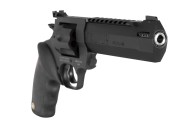Here are the different types of handguns and their practical purposes.
When you're new to the world of guns, it's easy to get overwhelmed with information. This is especially true when talking about the different types of handguns.
You have probably heard terms like double-action vs single-action and pistol vs revolver.
If you're confused, don't worry about it. We will try to clear everything up with a basic overview on the different types of handguns out there and the most common uses for each one.
For shooting accessories, visit walmart.com.
Single Action Revolvers
A single-action revolver refers to a firearm where you must manually cock the hammer to fire it. Single action revolvers are usually of an Old West, cowboy-style like you might see in the movies. However, you'll also see this action in modern firearms like the Ruger Super Blackhawk. If you're confused about single action (or "SA" as it is often referred to as), remember that a single trigger pull drops the hammer. With each cock of the hammer, you can pull the trigger and fire a round.
These repeating handguns are fed by a cylinder that holds multiple rounds. On older revolvers of this type, the cylinder doesn't swing out. To reload, rounds are instead fed through into the fixed cylinder via a loading gate on the side.
Here in the United States, single-action revolvers were used in the past as service firearms through the late 1800s. Today, they are usually used for target shooting or hunting purposes.
You'll find these guns chambered in rounds like .45 Colt, .44 Magnum, .357 Magnum or .38 Special. You'll also sometimes find rimfire examples in .22 long rifle.
Double Action Revolvers
With a double action (DA) firearm, the user has the option of either manually cocking the hammer or simply pulling the trigger. If you pull the trigger, the firearm automatically cocks the hammer for you. Remember it like this: if you pull the trigger and the hammer cocks, those are two distinct actions, hence double action.
A good example of a double action revolver is the legendary Colt Python.
The difference between the use of these two options is that cocking the hammer manually on a double action gun will generally result in a lighter trigger pull. Some people prefer to do this for more accuracy, but it varies from shooter to shooter.
These revolvers usually feature a cylinder that swings outward to load. They also can feature an external hammer like the Taurus Raging Bull, but some, like the Ruger LCR, feature a "hammerless" design where the hammer is concealed entirely within the frame.
The benefit to a hammerless design is for concealed carry. Having no hammer means there are fewer external moving parts or extruding pieces for the gun to hang up on while you draw it from its holster.
You'll find these revolvers chambered in just about any caliber you can imagine, from the little .22 all the way to up to .454 Casull!
Double action revolvers are used for a variety of tasks. They were even used by law enforcement officials for a long time in years past. These days, the larger caliber guns with a greater barrel length are generally used for hunting or bear defense purposes. Guns like the Smith & Wesson 500 are a good example of this.
Other revolvers, like that Ruger LCR we mentioned earlier, are usually self-defense guns. You'll find those in popular self-defense rounds like 9mm, but also larger rounds like .357 Magnum and .44.
Double actions are some of the most common revolvers you'll find on the market and you'll find they have a plethora of uses depending on the caliber and overall size of the firearm.
Semi-Automatic Handguns
Next to the double action revolvers, semi-autos are the most common type of handgun sold today. Some confusion arises here because some revolvers are semi-automatic too. The difference is, revolvers use a rotating cylinder of chambers to put the next round in position to be fired. However, most semi-autos use a single chamber.
A semi-auto firearm uses the energy from a fired round to eject the spent casing and position the next round in the chamber to be fired. There are variations in how this action works including gas, recoil operated and blowback. We won't get into those systems here because they're more technical, and deserving of a whole other article on their own.
All you need to know is that a semi-auto handgun will fire one round each time you pull the trigger. Because of their design, semi-autos can often hold more rounds than revolvers. The rounds are fed by a magazine in the handgun's grip.
You may have heard the terms "single stack" and "double stack." This simply refers to the type of magazine. A single stack magazine is thinner and holds all rounds in a single column or "stack." Single stack guns are thinner and usually used for smaller rounds like .380 ACP, which makes them highly concealable for self-defense.
A double stack magazine is just how it sounds, two columns of rounds in a single magazine, but spaced in a way that only one feeds into the chamber at a time. While most single stacks don't go beyond seven to nine rounds, you can often get double stacks that will hold 13-20 rounds. This will vary depending on the gun and caliber. A good example of a double stack handgun is the Beretta 92FS or the Glock 19.
Semi-automatic pistols can be double action, single action or a combination of both, which is known as double action/single action or DA/SA. The Sig Sauer P226 is a good example of this. It simply means the firearm can do both. The P226 has an exposed hammer that can be engaged to a firing position by racking the slide. However, with the safety off and hammer down, it can also fire when the pull of the trigger lifts the hammer for you.
Another type of handgun that doesn't really fit the single action/double action mold is a striker-fired gun. Instead of a hammer, these guns use a striker pin system to fire the round in the barrel. Glocks are a popular striker-fired gun, but guns like the Springfield Armory XDM, the Heckler & Koch VP series and the Walther PPQ have all grown to be just as popular.
Some of the more common ammo calibers for semi-auto handguns include .40, .45 ACP and 9mm, however larger calibers like 10mm can be found. Some guns, like the famous Desert Eagle, are gas-operated and fire the gigantic 50 caliber Action Express round.
Single Shot and Break-action
We'll group these two together because they're less common and often very similar to one another. Single shot is self-explanatory, the gun can only chamber one round at a time. A good example of this gun is the Thompson/Center Contender. This gun is both break-action and single shot and is available with extremely long barrels. The Contender is designed with big game hunting in mind, as are most single-shot handguns.
However, there are exceptions to the rule. Take for instance the folding Lifecard in .22lr from Trailblazer firearms. This gun is designed to be ambidextrous in design and there's nothing fancy about it; it doesn't even have a trigger guard. The gun is made of polymer and aluminum and folds up to the size of a credit card. It's designed for maximum concealment and is more of a "last ditch" type of firearm.
Break action handguns also include short, twin-barreled derringers designed almost exclusively for self-defense like those made by Bond Arms. They're small, discreet and made to pack a punch. You'll find these firearms chambered in calibers like .45 Colt and .357 Magnum.
In recent years, break-action derringers chambered to take both .45 Long Colt and .410 shotshell have become extremely popular as self-defense firearms.
Both single shot and break action tend to be exclusively utility firearms for hunting and defensive purposes.
There's plenty more to read about in our Guns and Ammo sections, but that should give you a good amount of info on the types of handguns there are.
For more outdoor content from Travis Smola, be sure to follow him on Twitter and check out his YouTube channel.
NEXT: TOP 5 OPTIONS FOR 9MM SELF-DEFENSE AMMO
WATCH





